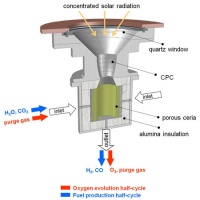Aldo Steinfeld, a professor of mechanical and process engineering at ETH Zurich and head of the solar technology laboratory at PSI, led the team that developed the reactor with researchers at the California Institute of Technology in Pasadena, California.
The reactor makes use of a solar-driven thermochemical cycle for splitting CO2 and H2O using metal oxide redox reactions. The two-step cycle consists in thermally reducing non-stoichiometric cerium oxide at above 1,500°C and re-oxidising it with H2O and CO2 at below 900°C to produce H2 and CO — known as syngas, the precursor of liquid hydrocarbon fuels.
’The operation at high temperatures and the use of the entire solar spectrum provides a thermodynamically attractive path to solar fuel production,’ said Steinfeld.
The solar reactor consists of a cavity with a small windowed aperture into which concentrated solar radiation enters. The dimensions of the cavity ensure multiple internal reflections and efficient capture of the incoming solar energy. A porous, monolithic ceria cylinder inside the cavity is subjected to multiple heating and cooling cycles to induce fuel production. Reacting gases flow radially across the porous ceria cylinder, while products from the reaction exit the cavity through an axial outlet port.
Experiments on the reactor have been carried out at PSI with a 2,000W solar reactor prototype subjected to a solar concentration greater than 1,500 suns. The measured solar-to-fuel energy conversion efficiency — defined as the heating value of the fuel produced divided by the solar radiative power input — reached 0.8 per cent.
’This efficiency value is about two orders of magnitude greater than the one observed with state-of-the-art photocatalytic approaches for CO2 dissociation,’ said Philipp Furler, a doctoral student in Steinfeld’s group, who is currently working on the reactor optimisation with help of fluid mechanics and heat-transfer simulation models. Thermodynamic analyses show that efficiencies above 15 per cent are attainable.

Steinfeld and his team are now focusing on optimising the solar reactor technology with the aim of building megawatt-sized systems.
’The potential of solar fuels has been repeatedly overestimated in the short term and underestimated in the long term. We still have plenty of research and development work to do, but by 2020 we should witness the first industrial solar fuel plants coming into operation,’ said Steinfeld.





JLR teams with Allye Energy on portable battery storage
This illustrates the lengths required to operate electric vehicles in some circumstances. It is just as well few electric Range Rovers will go off...